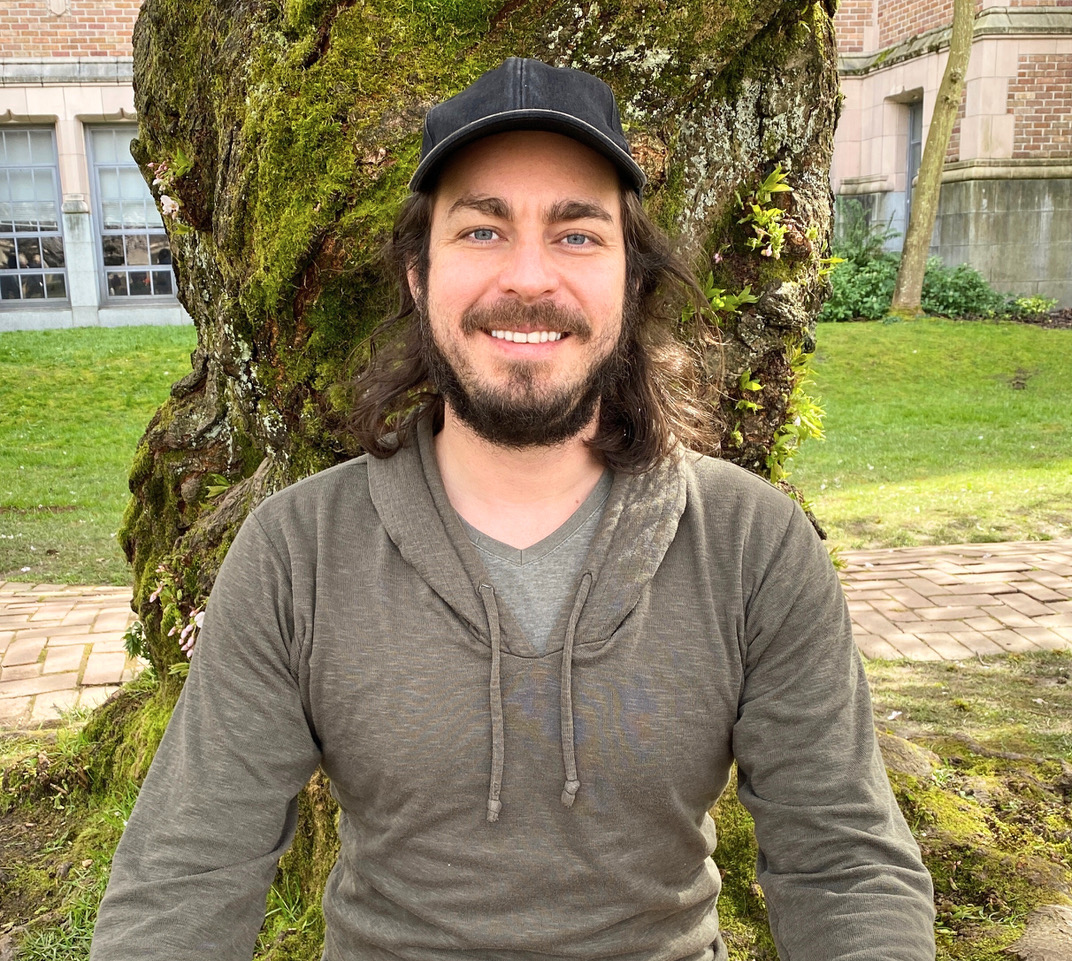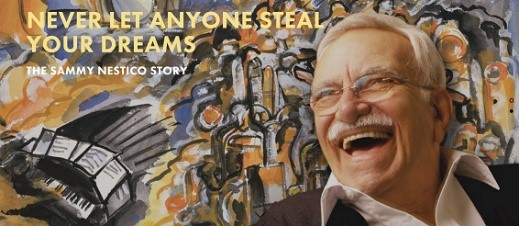Please check out these blogs from our incredible guest bloggers, who are experts in a wide variety of fields in the world of independent filmmaking and film funding.
by C.M. Conway
When embarking on a journey to make my first film, I studied the history of women filmmakers and discovered a hidden treasure: a large society of prolific female filmmakers before the era of “talkies.”
In fact, the silent film industry was led by women producers, directors, writers and actors (many multihyphenates). We owe a great debt to them, as they pioneered the way to form the foundations of the art and craft of cinema.
The careers of many of these women soured when sound was introduced in movies. Theories abound as to why this occurred, ranging from the director-orientated system transitioning to studio-orientated; to good old-fashioned capital and the industrialization of movies. In an article from the 1920s, Terry Ramsaye was quoted in Photoplay stating, “Every element of the creative side of the industry is being brought under central manufacturing control.”
Mary Pickford’s contributions to silent film are well documented, and she’s one of its
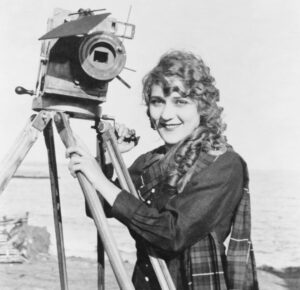
most recognizable faces. In 1916, Pickford not only starred but had full reign over the making of her numerous films. In 1919, Pickford, D.W. Griffith, Charlie Chaplin, and Douglas Fairbanks gathered to form United Artists, adding distribution to Pickford’s versatility.
But hidden in history are the stunning contributions of a worldwide community of female filmmakers in silent film, a sample listed below. Countless left established studios and founded self-named companies and did it all: acting, writing, producing and directing. Some partnered with their husbands in forming companies. All broke barriers.
Lois Weber was a major director and producer at her own company and made over 400 films.
Gene Gauntier was an influential actress and writer who co-founded a company. Wrote the first script of Ben-Hur.
Flora Flinch was an actress and director of her own films. Made 250 shorts with John Bunny.
Cleo Madison was a writer and director at Universal Films.
Ann Brody (Goldstein) was a groundbreaking film actress. Performed on stage over 50 years.
Mabel Normand was an actress, writer, director and founder of her own company. She was a major influence on Charlie Chaplin and the early Keystone comedies.
Marion Leonard acted with Mary Pickford and one of the first actresses to be billed on screen.
June Mathis wrote over a hundred produced screenplays, the first female executive at Metro Pictures and a founding member of the Academy of Motion Picture Arts and Sciences.
Texas Guinan was an actress, producer and considered the first cowgirl in movies.
Dorothy Davenport Reid was from an entertainment family and produced, directed, wrote and formed her own production company. She notably employed female writers.
Alla Nazimova was a skilled actress born in Crimea, producing risky and experimental work.
Marion E. Wong was a Chinese American actress, producer, director and screenwriter who founded her own production company in Oakland.
Beatriz Michelina was a Mexican actress and producer.
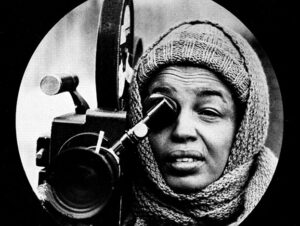
Tressie Souders was one of first female African American directors, and started a company.
Maria P. Williams was an African American who started a company.
Alice Guy-Blaché was a French immigrant and pioneer filmmaker, credited as one of the first to make a narrative fiction film and direct a film (from any gender). Owned a film studio.
Lillian Gish was a director and prolific actress.
Anna Hofman-Uddgren was Sweden’s first female director and a savvy businesswoman.
Elvira Notari was a director and considered Italy’s first female filmmaker responsible for the Golden Era of Italian Cinema. Her films were censored by the Italian government in the 1920s.
Dorothy Arzner was one of the first women to direct a talking picture and join the Directors Guild of America.
Germane Dulac was an influential director, thought-leader and leader of French film unions.
Fatma Begum is considered India’s first female director, an innovator in fantasy film and special effects.
Additional women who formed their own film-related companies: Helen Gardner (one of the first), Clara Kimball Young, Eve Unsell, Marion Fairfax, Lillian Case, Leah Baird, Norma Talmadge, Lucille McVey Drew, Anita Stewart, Florence Turner, Florence Lawrence, Constance Talmadge and Helen Holmes (also choreographed her death-defying stunts on-camera).
These filmmakers made it possible for women like me to obtain my dream of making a feature film. It happened after I ditched Hollywood and moved back to my roots in the North Bay, California. I wrote the screenplay that’s become the new completed film, “How to Successfully Fail in Hollywood.” Inspired by my own bodacious blunders as an actress, it’s a funny “how-not-to” guide, revealing the secrets inside Tinseltown. An ode to all struggling artists with a dream.
As much as I’ve experienced doors slamming in my face in Hollywood, I was amazed at the momentum that occurred when I took the reins as a filmmaker. It just took hard work, the efforts of a dedicated cast and crew; and a remarkable, grassroots effort in the Bay Area, Los Angeles and Sonoma County (many local businesses star in the movie).
In producing, directing, writing, editing and co-starring in a movie; I was emulating the very heroines I deeply admire in the silent film era. They are silent no more.
______________________________________________________________________
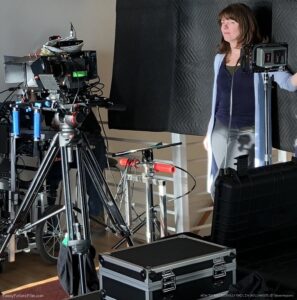
In her first feature, “How to Successfully Fail in Hollywood,” filmmaker C.M. Conway filmed in the Bay Area and L.A.The funny, poignant narrative film about friends, fantasies and fails has its premiere digital release on April 1st, 2023. Find it on your favorite platform at FunnyFailureFilm.com. The grassroots indie is a champion of women, gender equity, diversity and authentic representation of the Latinx and LGBTQIA+ communities. Award-winning Lisa Stoll provided cinematography; and experienced engineer Daniel Hess provided sound services.
Sources: Book: Pink-Slipped by Jane M. Gaines (2018)
Article: “10 Influential Female Directors From the Silent Film Era” by Sarah Nour (2022)
IMDb.com
Recommended Viewing: The Movie, “This Changes Everything” (2019)
Article submission for Women’s History Month (March, 2023). Copyright © 2023, C.M. Conway
by Diane Estelle Vicari
2001 is a year to remember. My first co-directed and produced independent feature film opened theatrically. SUGIHARA: Conspiracy of Kindness is the story of Japanese Consul General Chiune Sempo Sugihara, who during World War II saved the lives of thousands against his government’s orders. I was finally going to share this inspiring story of how “one man can make a difference” with a live audience. That is, until I received an invitation from scoring and recording mixer Tommy Vicari.
Tommy invited me to visit the famous Hollywood Capitol Records recording studios and to document a five-day recording session. I would “bear witness,” he said, “to history in the making.”
Being a one-woman band with a scheduling conflict on the same week of my Première, I kindly declined the offer. Tommy kept insisting — which was so uncharacteristic of him — until he eventually broke down my resistance. I agreed to hire a crew of four camera operators, direct them on the first day, and then leave them to continue filming, so that I could attend my special date with my audience.
As long as I live, I will never forget witnessing through my viewfinder, as this Geppetto-like figure walked up to his podium. The energy of the room immediately shifted. I watched the musicians straightening themselves in their chairs, as if a four-star general had entered the room. Then, Maestro Sammy Nestico gave the down beat.
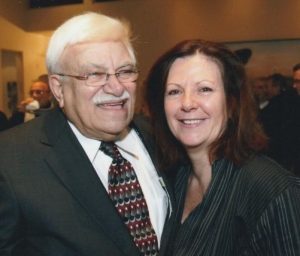
I had been around music since I was a child, playing the piano for seven years, attending weekly rehearsals and performances of my Grand-Maman Estelle’s choir at church, being always a step behind the fanfare during parades, and of course having been married to a recording and scoring engineer for nearly twenty-five years. None of it prepared me for the moment when Sammy Nestico’s music began to play.
I was awestruck and overcome with a sense of pure joy and wonderment at this humble man, who was yet a force to be reckoned with. This tangible magic continued to fill the studio for days and I was moved to keep filming.
What I experienced during these five days; the world had to see. I missed my own opening night in order to capture the enchantment.
On that day, our twenty years journey together began. I entered his world and committed to making a documentary film about his life story but mostly to share his message to: “Never Let anyone steal your dreams.”
Sammy passed away January of this year, one month short of his 97th birthday, As his wife Shirley entered the painful process of letting go, she invited me to come to their home to see if there was any items I may need for the film. At one point, I noticed his ties collection, which she had prepared for a donation.
At the age of 16, this first-born son of Italian immigrant began wearing ties so that he could be considered a “serious” musician. He began his collection of ties, and that tradition continued throughout his life. He often wore them only once, and purchased another for a new occasion! I asked Shirley if I could keep this collection.
For Sammy’s 86 Birthday and his 4th Grammy nomination, jewelry designer Pepi© exclusively created “Sammy’s Love Note©.”
exclusively created “Sammy’s Love Note©.”
After sharing this story with her, she suggested we bring back his “Love Note” pin and offer it with a collectible tie.
For a $179.00 donation towards the completion of the film, you will receive “Sammy’s Love Note©” and choose one of Sammy’s collectible tie.
Please click on this link that follows to make a selection.
https://www.sammynesticofilm.com/rewards/1dof5en3ox3gt3sebg1h97pbe6d8cb
I am privileged to be the messenger of this world-renowned musical legacy and one of our National Treasure, Maestro Sammy Nestico.
Bill Woolery, the editor behind the trailers for such films as “ET” and “The Usual Suspects”, was known as “The Trailer Specialist.”
This blog was written for us by Bill when he was a donor to the Roy W. Dean Grant. In this, he offered his advice on documentary trailer editing drawn from his 25 years of experience. He also wrote a chapter in Carole Dean’s book, “The Art of Film Funding.”
by Bill Woolery – Guest Contributor
In the complex business of getting your documentary funded and distributed, having a dynamic, well-edited video promo has become a critical element in a successful strategy. But often when the producer/editor turns his attention to creating this kind of trailer, the results can be less than satisfactory.
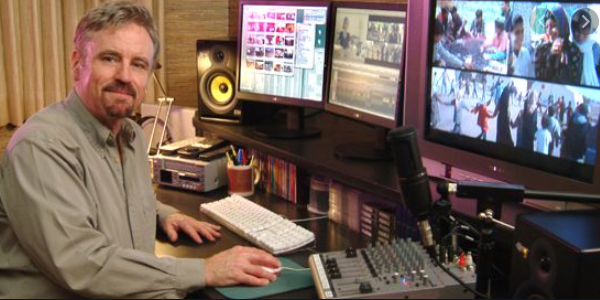
Why? Because long-format pieces and trailers are two completely separate video realities. Each has its own rhythm and energy; each uses a different language to express the same emotions. Editing a documentary benefits from a well-developed, logical Left Brain …while trailer editing is much more a Right Brain exercise. Structurally existing in different worlds they nevertheless are both true and faithful to the concept and the heart of the overall project.
Trailers for documentaries are used in two ways. One format’s goal is to impress funding entities with the importance of the project and the value of contributing to it. In this case, the editor takes whatever footage is available and attempts to recreate the theme and quality of “whole picture.” The other trailer format is created from the completed documentary and is used to showcase it to potential distributors, broadcasters & home video releasing companies.
RHYTHMN & PACING
You’ve worked hard and are satisfied with the pace and rhythm you built into your doc. This is surely an asset that you want to preserve in the trailer, yes? No! Taking various chucks from your doc and assembling them into a promo without totally rethinking the editing will produce a clumsy, ineffective result. Individual & overlapping arcs, the “build” in momentum, the emotional “gear changes” that characterize a great trailer have little in common with the corresponding elements in the full-length piece.
Yes, the trailer will try to cover all the salient points and emotions it can, but the way that these play off each other and contribute to the whole requires a different construction. True, the trailer may be 50 or more minutes shorter than the doc, but if it’s a great cut nothing will be “lost” from the integrity of the full piece.
VOICE OVER
Few things will reduce the impact of a trailer more than the use of an amateur Voice Over
A RULE THAT NEVER FAILS
LET THE MATERIAL LEAD YOU.
“We’re thinking it should be 3 minutes,” I sometimes hear. “Does that sound right to you?” In theory, yes. But, as the cut begins to hone down into a solid form, the intrinsic qualities of the material become the determining factor in these kinds of decisions.
In the trailer mind-set, you’ll find that the material will “tell” when it’s been on the screen long enough. It will tell you when you’ve revealed too much of it, or if you need to add a bit of setup so that it can “speak” more clearly. It will tell you if the music cue is wrong. I usually like to build a long sequence first and then allow the scenes to tell me which of them are superfluous and which should remain in the cut.
“BUT WE ALREADY PAID FOR THIS MUSIC”
In scoring your doc you’ve probably made many choices using music sensitively and episodically. But music in a trailer runs continuously -with rare exceptions for dramatic pauses. It must have momentum, a pulse that propels the trailer (either strongly or gently) from top to bottom. If your doc already has such a cue, you’re in luck. If it doesn’t, there’s little alternative to finding a new cue. You could also ask your composer to create faster tempo versions of the existing cues.
If you use several cues in the trailer always start with the slowest tempo first and proceed with quicker and quicker ones. This rule can be broken …but the only exceptions I’ve encountered were due to unusual circumstances, say when the trailer has to end on a tragic note that follows a more active and expositional middle section. It’s not a particularly good idea to end a trailer tragically. No need to devise a “happy” ending, but it’s a better choice to leave it open ended with a bit of mystery about the people and the outcome.
MAKE SURE IT ENDS
Avoid a slow music fade out at the end. Yes, your doc may have a beautifully constructed, delicate ending that leaves the viewer in tears. Your trailer can also invoke a similar poignancy …but it must have a definitive ending. Why? The viewer may leave your doc a changed person, pondering a new awareness.
But when the trailer ends, he or she needs to be thinking, “Hmm, I really want to see that.” That’s the “new awareness” you want to create here. This need not be seen as a “selling out” or a commercializing of your project. It’s just the way a trailer has to work. A good trailer cut will not compromise the integrity to your project.
AN EDIT ROOM SECRET
Invite the clients to sit down the first time they view the trailer cut on the monitor. A standing person can be uncomfortable and will perceive the cut to be longer than one who is sitting. Whenever I hear, “It feels just a bit too long,” it’s always from the person standing.
In Creating the CARES Act, Congress Gave Everyone the Opportunity to Be a Little More Charitable
by Richard Kaufman – Guest Contributor
In crafting a response to the disastrous economic impact caused by the Covid-19 crisis, Congress created the Coronavirus Aid, Relief, and Economic Security Act (known as the CARES Act). Most of us are familiar now with its Emergency Small Business Loans, Paycheck Protection Program, and disaster loans. (And most of us who applied for those are familiar with not getting a response to our applications)
Did you know the CARES Act also boosted tax incentives for charitable giving?

Congress realized that the crashing economy needed help beyond what they could provide. While millions have been thrown out of work, many others are still getting a paycheck working from home or at essential businesses. And, there are others who need not worry about working. So, they created a perk to get them to donate to charities.
The New Benefit for Donors
While charitable giving comes from the heart, there have always been tax incentives to encourage donations. Recent changes in the tax law have made it more difficult to get a deduction for giving.
Under the current tax law, if you itemize on your tax return, you can deduct donations to registered charities up to 60% of your adjusted gross income. Most people, however, don’t itemize and claim the standard deduction. Those who do this can’t deduct charitable contributions they make during the year.
But, now, as explained by in NPQ (Non-Profit Quarterly), the rules have changed temporarily under the CARES Act providing several benefits:
The stimulus bill also contains a one-time, above-the-line deduction for cash contributions of up to $300 made to certain qualifying charities. All taxpayers would be eligible to take the deduction, even people who use the standard deduction. The incentive applies to contributions made in 2020 and would be claimed on tax forms next year.
So, anyone, even if they itemize, can deduct up to $300 in charitable giving.
For the eight percent of individual taxpayers who itemize their deductions, the bill would suspend for 2020 the normal limit on deductions for contributions, ordinarily 50 percent of adjusted gross income (AGI) or 60 percent for cash.
This means that charitable contributions equaling up to 100% of your adjusted gross income are now deductible on your 2020 tax return if you itemize on it.
Of course, most people can’t afford to donate 100% of their income. But those HNI’s (high net worth individuals) will now have greater reason to part with their savings in order to help good causes.
Finally, corporate donation limits were raised as well.
For corporations, the limit on deductions for contributions, ordinarily 10 percent of AGI, is elevated to 25 percent for 2020.
What the CARES Act Means for Fiscally Sponsored Filmmakers
Having your film fiscally sponsored means your project has been accepted by a 501(c)3 non-profit, like From the Heart Productions, into their fiscal sponsorship program. This allows those making donations to those films to get tax deductions for their donations. Just like they would for other donations to any other charitable foundations.
And, under this new bill, donors can give more, get larger deductions, and get deductions where previously one had not been possible. This will make it easier for these filmmakers to continue to get funding and get funded faster.
Why Donate to a Fiscally Sponsored Film?
Films that are fiscally sponsored must fall under the mission statement of the non-profit under which they fundraise. For films fiscally sponsored by From the Heart Productions, these are films that are unique and make a contribution to society. They are important, life-changing films, by filmmakers with a passion for their work.
As Carole Dean, President of From the Heart Productions, says “Film is one of the most important art forms and it takes the longest to create.” These independent films take years to produce from conception, through pre-production, to finished product. A gap in their funding might mean some filmmakers would need to give up their projects. Especially, when they are under the weight of having to make a living right now as well.
What Fiscally Sponsored Filmmakers Should Do Right Now?
Make these changes in the tax law known to your potential investors. Include it in your pitch and on your crowdfunding pages.
Focus on going after large companies and wealthy individuals in 2020. This offer by the government for these new tax deductions is good for this year only.
Don’t miss this opportunity to make the most of it
The biggest challenge filmmakers have now in getting money for their project is proving to investors that they can make or finish a film during a pandemic
By Richard Kaufman – Guest Contributor
Your film investor is reaching for their Amex card after you’ve made your brilliant Zoom meeting pitch for your dream film project. They like your experience, your passion, your story, but they are asking themselves what everyone asks who ever thought of giving money to a privately financed independent film project.
“Is this film ever going to get made?”

In Spring 2020, that question has a new ominous twist fear behind it. We are in the middle of a health crisis that has put a hold on all our lives and filmmaking. Virtually no projects are being produced right now. No one is sure when anyone will start filming again.
Covid-19 Film Production Plan
Which is why, when you fund raise now for you film, you need Covid-19 Film Production Plan for investors and donors.
You need to be able to show anyone who is willing to give money to you for your feature, documentary, short film or web series that it will get produced and completed. If not soon, then sometime in the near future.
This plan, or least the mention of it, should go in all fundraising materials, crowdfunding pages, and in your pitch.
Pandemic Precautions May Last 4 Years
In a study published in the journal Science , researchers from the Harvard T.H. Chan School of Public Health have warned that, in the absence of a vaccine or an effective treatment of the coronavirus, social-distancing measures may be required through to 2022. It’s possible, they say, that we may need do this until 2024.
If you’ve made a movie, you know that social distancing on a set will be a challenge. Your investors and donors know how hard that is to accomplish social distancing in their daily live when take walks or navigate supermarket produces aisles avoiding others grabbing for the same avocados. They also know they’ve not been back to work as the places of business may not be able to accommodate social distancing or other requirements needed for employees to stay healthy.
What will make your business, your film project, different. How can everyone on it go to work, not become ill, and get it finished? What steps will you take to insure everyone stays healthy?
Do Your Research
Fortunately, the entertainment business is filled with creative minds sharing ideas to get production started. There are many plans and proposals circulating from producers, directors, and unions.
Variety Magazine recently wrote about how Producers Brian Kavanaugh-Jones and Chris Ferguson — from the companies Automatik (“Honey Boy,” “Bad Education”) and Oddfellows (“Child’s Play”), respectively — have created a proposal titled “Isolation Based Production Plan.”
In their proposal, they raise issues that you will should think about address in production of making your film.
- Quarantining Cast and Crew – The entire cast and crew would be in a two-week quarantine before they would begin production, and would be tested.
- Quarantining Costumes, Props and Sets – Locations and sets would be dressed, and then sealed for three days (or whatever the most conservative estimate is) “to allow viruses on surfaces to die.”
- Limited Hair and Make-Up Contact – Instead of working on multiple actors at once, the proposal suggests there would be a single person working on one actor at a time — and not on set. “Makeup application tools & supplies will be purchased per cast member and used only on that individual cast member.”
An article in Deadline called Reopening Hollywood, brought up other areas that need to be addressed including:
- No More Cafeteria Style Craft Service Meals – Meals will only be doled out in single-serving pre-wrapped fashion. There will be no shared utensils. Lunch breaks will have to be staggered, to cut down on density.
- Protecting Talent and Directors on Set – Below the line personnel coming into contact with actors or directors will have to wear masks and gloves at all times.
- Eliminating Extras and Day Players – Perhaps cut out crowd scenes or if necessary, use green screen.
More Guidelines and Covid-19 Film Production Ideas
Production safety protocol suggestions from studios, trade groups, and film commissions.
Ted Sarandos, Chief Content Office at Netflix, offered his thoughts on How film and television production can safely resume in a COVID-19 world.
The Association of Independent Commercial Producers (AICP) just issued their department specific production guidelines.
Film Florida released a list of detailed recommendations for safe sets.
Independent film crew members discuss what is on their wish list for a healthy and safe film set in Indiewire
What Covid-19 Film Production Plan Works Best for Your Film
The Covid-19 situation and what we know about the disease changes daily. The production needs for every project is different as well. Some require locations and some sound stages. Maybe on your project, the director and DIT can work remotely.
Whatever you feel is necessary to make your film under current conditions, write it down. Modify your script if necessary, to accommodate safe working conditions.
Let your investors and donors know that you have a plan.
From the Heart Productions thanks Roy W. Dean Grant Winner Helen Hall (“Pictures of Infinity”) for generously sharing with us tips for filmmakers on how to use Facebook to build a community for their film as well as how to use it to maximize their films crowdfunding campaign on our new WeDidit Platform
By Helen Hall
Within our present situation of isolation and uncertainty, my thoughts as a filmmaker immediately returned to one of the many ways of moving forward with our films you have shared with us from the beginning: that we are no longer making films for an audience, but with them.
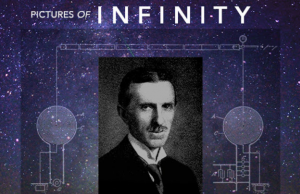
I believe this time we have now is ideal for creating and building community around our films, and so I am sharing some of the tools I think might be useful for other filmmakers, as we are also migrating this month to a new fundraising platform filled with new possibilities.
I had created a Facebook page for my film “Pictures of Infinity” years ago, but didn’t know where to begin to connect with a larger community. I learned so much from a crowdfunding expert that I was connected to by From the Heart Productions about how to do exactly this. Now, I am posting regularly and engaging with a community of 17,700+ like-minded souls on the page.
A few months ago I was contacted by a marketing expert from Facebook. They offered to guide me through some of the tools that make it possible both to create ad campaigns with specific goals in mind, and with them to extend the reach of the audience.
I have learned it is possible to reach the audience with a combination of targeted ads and posts to the page that are boosted for maximum impact.
Here are some of the tools I am learning how to use:
Facebook – Audiences
On the Facebook page for our film (known as a business page) there is a tab at the top called ‘Ad Center’. On the left of the Ad Center page are three vertical headings: Overview / All Ads / Audiences. Click on ‘Audiences’ and on the top right is the option to ‘create audience’. It is possible here to create custom audiences for your film, and to save them for future use.
Facebook Ads – Formats
Image formats: ideal size for images = 1,200 X 628 Px, in JPEG or PNG format.
If the image includes text, the text can be no more that 25% of the image, or Facebook will not run it.
(see link to tool to measure text on images for Facebook)
Facebook Pixel
Facebook Pixel is a code that collects data to help track conversions for Facebook Ads.
Look under ‘Business Settings’ for ‘Events Manager’. Click ‘create a pixel’ and follow instructions.
WeDidIt – Fundraising Platform
The Donation page is divided into ‘content’ on the left, and a donation menu on the right. The content section is 690 Px. wide.
The page accepts video files – MP4 format, and images in JPEG and PNG formats. Video and image files will automatically resize when uploaded. There are traditional text options for choosing fonts, sizes and colors.
I was told by tech support at WeDidIt that there is no limit to the amount of content for this page, most films include a fundraising trailer, a few images and a short synopsis of the film.
Facebook Pixel – look for the ’Settings’ section in the vertical menu on the left of the page near the bottom. Click ‘Analytics’ and add the Facebook Pixel.
—
Here is a link to video tutorials to help with the WeDidIt platform and a list of links for learning more about how to use Facebook for our film projects:
—
Video Tutorials – WeDidIt:
https://wedidit.zendesk.com/hc/en-us/articles/360039175052-Platform-Video-Tutorials
Facebook Creative Inspiration:
https://www.facebook.com/business/inspiration
Facebook Ads Guide:
https://www.facebook.com/business/ads-guide
Facebook – Free Online Training Courses:
https://www.facebookblueprint.com/student/catalog
Facebook – Advertiser Help Center:
Step-by-step instructions. Please refer to the Advertiser Help Center to find answers or contact support, if you have trouble.
https://www.facebook.com/business/helpv
Facebook Ads:
https://sproutsocial.com/insights/facebook-ad-sizes/
Image format for Facebook Ads:
Check ratio of text to image here:
https://en-gb.facebook.com/ads/tools/text_overlay
Facebook Audiences:
About the Reach Objective –
https://www.facebook.com/business/help/218841515201583?id=816009278750214
Increase awareness of your business or brand by using the reach objective.
Understand how your Reach Objective performed
https://www.facebook.com/business/help/1639908612985580?id=816009278750214
About Connections Targeting
https://www.facebook.com/business/help/1819812758298988?id=176276233019487
About Detailed Targeting
https://www.facebook.com/business/help/182371508761821?id=176276233019487
About Lookalike Audiences
https://www.facebook.com/business/help/164749007013531?id=401668390442328
Facebook – Client Services Link:
https://www.facebook.com/business/resources
 Helen Hall is a Montreal-based composer who explores an intuitive understanding of music as energy in her varied works for voices, instruments, electroacoustics, dance, theatre and film.
Helen Hall is a Montreal-based composer who explores an intuitive understanding of music as energy in her varied works for voices, instruments, electroacoustics, dance, theatre and film.
Her music is inspired by natural, acoustic phenomena such as the rhythm of breathing (Circuits), the harmonics and interference patterns of multiple saxophones (Fluvial), and the natural frequencies of the earth’s magnetic field (Infinity Maps).
In recent years her work has become more research-based, and she has been extending her music into film. Powerlines, her first film, is a documentary about the mystery of electromagnetic fields, which began as a musical score based on the sound waves of artificial electromagnetic radiation. Pictures of Infinity, her second film, is a feature documentary about Nikola Tesla’s unique understanding of nature and its inherent connection to acoustic principles of energy.
Top filmmaker and documentary consultant Karen Everett discusses fast track editing: the art of getting films to editors, and working with them at all stages of production.
by Christopher Eyte
WHEN it comes to experience in the film industry, it would be hard to beat the achievements of Karen Everett. As one of the world’s leading documentary story consultants, Karen is also an award-winning documentary filmmaker who has taught editing skills for nearly 20 years at the Berkeley Graduate School of Journalism at the University of California. Karen owns New Doc Editing, a pioneering editing and consulting business helping filmmakers structure compelling documentaries for venues such as PBS, HBO, Sundance and other top film festivals.

Karen is a fount of wisdom when it comes to making documentary films and shared it during her visit with Carole Dean of From the Heart Productions on The Art of Film Funding Podcast.
In particular, she has some great tips on logging guidance: how to get out of production into post-editing and best methods for a successful rough-cut screening. As a professional who has notched 30 years in the industry, one of the most exciting changes Karen has seen is the rise of inspiring documentaries, as she calls them, as opposed to films preoccupied with ‘what’s wrong with the world’ such as homelessness and climate change.
Audiences want positive social action documentaries
“I think [those films] were needed at the time to open our eyes but I recently read that Jerry Seinfeld said documentaries have a reputation for being ‘incredibly depressing’. That’s changing. For example, people will go to see a film that is about a Supreme Court justice who fought her way up the ladder, or about Fred Rogers. These [new] films focus on protagonists who are doing something, they’re not burying their head in the sand, they’re doing something to change the world.”
The new focus in modern documentaries means that filmmakers and media bodies such as CNN are choosing stories which are more positive and meaningful, according to Karen. There’s still a role for investigative documentaries in her opinion, but her story consulting work is seeing documentary makers taking a more positive emphasis on social issues.
Accelerated Post: 10 weeks to completed edit
Karen knows the challenges of funding film making and that is why she is supportive of the sterling work by From the Heart Productions. Her own business, New Doc Editing, is focused on lowering the costs of making films. The editor’s input plays a key factor in that budgeting, as well as time taken in editing. A one-hour PBS documentary edit used to take about six months to edit the 30 hours of footage. Karen says that her company’s new program, called Accelerated Post, will edit the documentary in 10 weeks or less, with a weekly editing fee of $3,000. It is a fast-track, post-production process.
“Frankly, if you’re paying less than that for an editor, I would seriously check their credentials. One of the reasons we can do it in 10 weeks is because our handpicked editors, they’re in the top five per cent of editors and they’re good… fast! And you also get me as a story consultant. We hone in quickly on the filmmaker’s vision and what needs to happen to execute that. Is it going to be a story-driven documentary? We need to get really clear on the structure of the film before we start editing. If there’s not a story (in the sense of a character on a quest), then it’s probably an essay-style film.”
One of the first questions Karen asks is, “what are the seven top ideas’ needing to be created in the film. The director is then guided to cut footage down to 30 hours – overshot is a common issue. The first three weeks are then spent working on an assembly cut, getting the best footage together. A couple of two-week rough cuts will follow, working out the film structure, story and employment of characters. Lastly there will be a two-week fine cut and a week for the picture lock.
Your job is to deliver a protagonist/character-driven film to New Doc Editing
Karen doesn’t promise strict timings for the process ‘because it’s not up to us when a film is done’ – but she knows how to speed up the process. The guideline for getting it down to 30 hours is to create a sequence if it’s a protagonist/character-driven film. The character is on a quest so using text on screen and markers helps to gather the plot points. She advises choosing the key moment in a given scene and then ‘throw that into a sequence of plot points’. Surrounding clips can then build the scene and separate sequences created for each main character. This helps to see the story and if it’s sustainable.
The director’s top seven ideas in the film might involve seven sequences focused on ideas in the documentary. This can seem a lot of work when logging for the edit ‘when you’re sitting before a mountain of footage’ but if you follow certain techniques, Karen finds the process is not so time consuming and boring.
It’s your choices that quicken the edit
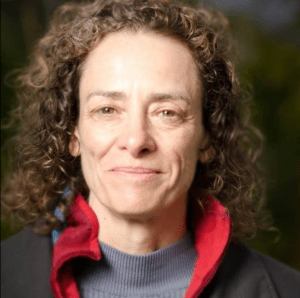
“Your mind has to be very sharp because you’ve got this list of criteria: the key plot points, the key ideas in your making. You’ve just got to force yourself to make a decision about, for example, if two people say the same thing, which person says it best?” Karen’s final tip is technical: don’t rename your clips, which are six-digit or alphabet/numerical titles. “The camera gives it. If you rename it, then it can be hard to read, link the footage and slow down.”
Can we trust her editors? Karen believes trust is key – finding that the person who fits and feels right for the work; and also trust in terms of experience and credentials. She only hires editors that have two feature documentaries ‘under their belts that have won awards’. A good editor should also be humble, willing to give a point of view but respect your editorial authority. Directors should at the same time have a vision and convey it, according to Karen.
You must tell us up front what is the protagonist’s ‘statement of desire’
But how do directors know when the filming is enough and it’s time for post-production? Karen says overshooting is a common mistake. The answer is ‘being clear about what the film is about’. Talking to a story consultant such as Karen will help give this clarity.
Being clear about the story is crucial so the viewer doesn’t have to second-guess the focus of the film. Karen calls this a ‘rule of thumb’ that the protagonist’s ‘statement of desire’ is made clear within the first five minutes of the film. An inciting incident, something happening to the character, will proceed this and galvanize the protagonist into embarking on the quest.
Karen adds that the importance of conversations is too often overlooked for character stories. She says documenting relationships in films ‘is very juicy’. Filming conversations, such as between two antagonists (e.g. as in Michael Moore’s films) is inherently dynamic and ‘often more fruitful than an additional solo interview or pick-up interview’.
How to save money with a story consultant
Story consultants, known as story editors in Hollywood, are fairly new in the world of documentaries and people don’t always budget for them. Even so, it’s helpful to have their input at both pre and post- production stage. Questioning the story basis and whether it is cutting edge is important, according to Karen: “A lot of filmmakers will, for example, want to make a film about Alzheimer’s Disease and following this amazing couple that they met and yet this kind of film has done before. So again, what can you add that’s new?”
Finding a story consultant saves money because it helps filmmakers be clearer about how to direct the camera. Some trailers don’t tell the story or the essence of the real film, and Karen believes that’s a big problem. “What is the central question that you are trying to answer? Or what is the thesis statement, the key idea that you are trying to… the case you’re trying to make?”
New Doc Editing offers professional help with editing documentaries that inspire. Karen adds: “I have a new website with lots of beautiful portfolio pieces of films we’ve worked on. Check it out!”
Find out more via newdocediting.com or drop Karen an email via karen@newdocediting.com
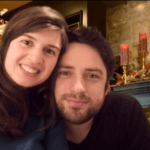 Chris & Céline Eyte, a husband-and-wife team, own Resurrect Media which is a premier news and content marketing agency based in Abergavenny, South Wales. Their mission is to tell the stories of clients by creating written or visual content, which is simply fantastic and achieves wonderful results. They specialize in writing and editing services, providing journalistic support, graphic and web design, and photography for events and products.
Chris & Céline Eyte, a husband-and-wife team, own Resurrect Media which is a premier news and content marketing agency based in Abergavenny, South Wales. Their mission is to tell the stories of clients by creating written or visual content, which is simply fantastic and achieves wonderful results. They specialize in writing and editing services, providing journalistic support, graphic and web design, and photography for events and products.
Director Robyn Symon’s first Kickstarter campaign for her documentary “Do No Harm” reached it’s goal. Could she make it happen again?
by Richard Kaufman
Documentary filmmaker Robyn Symon was told it was impossible for a film to have two successful Kickstarter campaigns. Her Roy W. Dean Grant winning film “Do No Harm” raised over $100,000 on the first Kickstarter effort. She needed to raise at least that much again to help get her film finished.
On The Art of Film Funding Podcast , she she shared with host Carole Dean tips on how she defied the naysayers and reached her goal the second time around.
Put Together a Team With Connections
“Do No Harm”, fiscally sponsored by From the Heart Productions, reveals the sad shocking truth about physician suicides. While their jobs are to serve as our healers , they have the highest rate of suicide among any profession.
She knew on her second Kickstarter campaign she would need to reach new supporters and expand her followers to be successful. To do that, she wanted to build a team who could connect with those in medical field.
She sought out those “who had vlogs, podcasts and they had like tens of thousands of followers.” She didn’t want anyone just because they loved the film. She selected 5 or 6 people after “I looked at their backgrounds carefully to know that these people knew how to connect with other people.”
One of them, Dr. Pamela Wible, Roybn called her “secret weapon”. She’s considered “the guardian angel to physicians and medical student suseptible to suicide.” Her vlogs get 50,000 views and a Ted talk she did seen by over 380,000 views.
With a team in place, they were getting word out about the film even before the campaign began.
Have Money in Kickstarter Campaign Before it Starts
“You should have a few thousand dollars already committed.” Robyn suggested. So, as soon as you pull the switch on the campaign, the money is already tallied for all to see.
“No one wants to be the first money in.”
Everyone on her team agreed to contribute $1,000 before the campaign went live. So, right at the start they already had momentum.
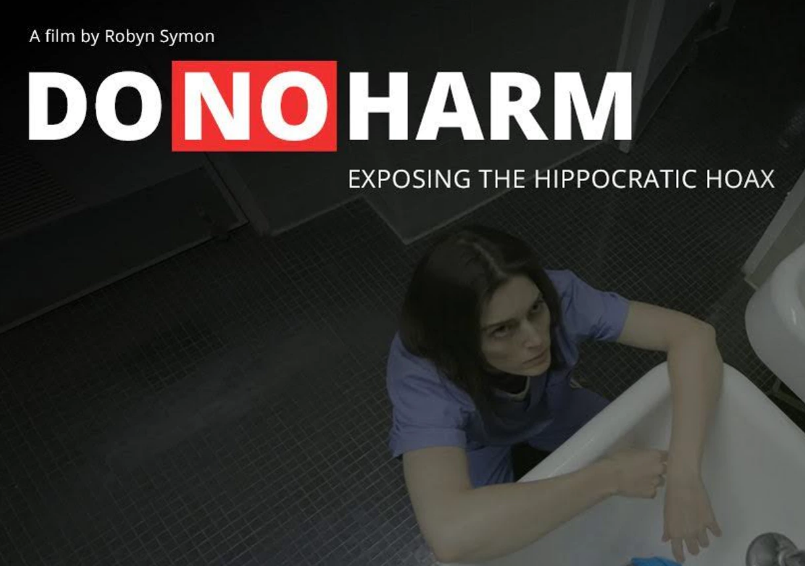
Don’t Have a Goal That’s Too High…Or Too Low
“If your goal is too high, you’re not going to be sucessful”, she said. Conversely, you don’t want to have a goal that is too low and easily attainable.
“Once you reach your goal its very difficult to raise more money.” She suggests not to go for all the funding at once in one campaign. Break it up into smaller asks.
“You have to make it very clear what the money is being allocated for” such as pre-production. So, when you go back for more funding, you’re not rejected by those who think you’ve already raised enough to make your film.
Consider Using a Kickstarter Campaign Expert
Because she was concerned about raising money a second time on Kickstarter and finding new supporters, she hired an Kickstarter expert.
From the Heart Productions has one expert they work with who has a fantastic track record of crowdfunding success with their fiscally sponsored films. They hooked him up with Robyn to help her with her campaign.
“I think it was really helpful.”, explained Robyn. “He has done so many of these campaigns that he really made the page look fantastic.”
She regretted not setting her goal higher as she reached it in a week! Her goal was $60K, but she really needed $100k and thinks she could have raised $200k.
“It’s tough, really tough, to go back and say “Yes, we reached our goal and we have 3 weeks left.’”
Fortunately, she was able to refocus her campaign on raising funds for marketing and was able to get an additional $60,000.
Richard Kaufman is a board member of From the Heart Productions; a 501(c)3 non-profit that offers fiscal sponsorship and the Roy W. Dean Grant for independent filmmakers. Richard has over 25 years experience in supplying filmmakers with discounted film stock and hard drives. He is currently a Senior Account Executive with Filmtools.
I was introduced to the law of attraction and learned that I could accomplish anything I put my mind to as long as I could imagine it and believe it, having faith that it could come true..
by Joy Cheriel Brown
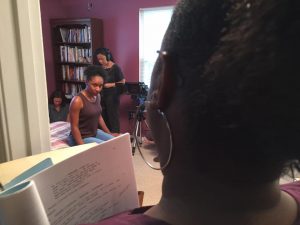
In 2012, I was digging around my home office and found a short script I had written eight years earlier when I was a Senior in college. It was a contender for my thesis film, but I had decided to put it away until later because it would have been a nightmare to find a location for it since the script was based on my first hospitalization for Schizoaffective Disorder, and I was taking a full load.
It was now years later and I had just started my production company when I found this script. I had always planned to do three shorts before I made my first feature film and the third short was always meant for the festival circuit. I would definitely need money to do this, and I had none.
I didn’t quite know how I was going to do this, but I had an idea of where I would get the money. For my second short film, I had gotten a grant from the philanthropic arm of a major telecommunications company. So I decided that I was going to get the financing for my third short film from another big company as well.
I knew that to get a grant from this company, I would have to get a fiscal sponsor because I was not a 501(c)(3) company and therefore, did not have non-profit status, which was the only way I would be able to get a grant from this company. I had no idea how to get a fiscal sponsor either.
During the summer of 2012, I was introduced to the law of attraction and learned that I could accomplish anything I put my mind to as long as I could imagine it and believe it, having faith that it could come true, and that when you have a dream, the universe moves people and circumstances to give you what you want. Because I didn’t know how to get a fiscal sponsor so I hadn’t made any attempts to get one, having so many other things that needed to be accomplished when making a film and building a team. Instead, I was applying for grants that could be awarded to individuals so I applied for the Roy Dean grant and let it go.
Several months later, after I had forgotten that I had even applied for the grant, I got a call from a woman who identified herself as Carole Dean. She told me that I while I did not get the grant, I was a good writer and she wanted to give me fiscal sponsorship. I took this as the first sign from the universe that I was going to get the project done.
I had already missed the 2012 deadline to apply for a grant from the company from which I was sure that I would get the money, so I had to wait for the 2013 deadline. When 2013 rolled around, I applied for the grant and was denied. I didn’t even bother to ask why. However, I reached out to the company again three years later, after two failed indiegogo campaigns, and this time, I got a call from a woman who remembered my application from a few years earlier and told me why they had rejected my application. So, I corrected that item and this time got it approved, even though it was hardly for the amount that I had asked for. Still, I took this to mean that I could get it done with the amount that they gave me and wouldn’t be able to pay all my cast and crew as I had hoped.
Moreover, by the time that the money would be awarded to me through the fiscal sponsor, it would no longer be the time of year that I wanted to shoot the film. The actual incident had taken place during the summertime and it was non-negotiable to shoot it at any other time of the year because I felt that it was significant. Plus, I didn’t want to rush to get the rest of the cast and crew together. Therefore, we would have to wait ANOTHER year before we could shoot, and I still hadn’t been able to find a location.
The next year, I brought on a location scout that did such a phenomenal job that I made her a producer. Previously, she would not have been available to take on such a large responsibility—ironically, I had met her the year I decided to make the film in 2012—but now timing was right. In 2015, I had met a director who would direct my first stage play who I also made a producer, and the three of us were sort of a dream team. If I had made the short in 2012, neither of these women would have been a part of the team, and I believe the film would have suffered for it.
Anyway, my location scout-turned-producer and I stumbled upon the perfect location for the film while checking out another space. The amazing thing about that was that before 2017, the space wouldn’t have been available because people were still living in it!
What I learned from this project is that everything happens in divine timing and at the right time for it to be most beneficial to you. We will release the short, N.O.S., later this year, and the universe continues to arrange people and circumstances as we complete the project.
Joy Cheriel Brown has studied screenwriting since 1991. She has an MFA from National University for Creative Writing, with a concentration in Screenwriting, and a Bachelor of Arts from Howard University, where she studied Film and English and graduated summa cum laude.
She has either won or placed in several contests and has had many of her screenplays chosen as official selections in the DC Chapter of Women in Film and Video’s Spotlight on Screenwriters catalog from 2014-2017 and has served as a mentor on screenwriting panels for DC Shorts and Prince George’s Arts and Humanities Council’s Festival of Literary Arts.
Joy also wrote, produced, and directed the short film, Figment, in 2004, and was the writer and one of the producers for the short film, One Chance, which premiered at the Bowie Performing Arts Center in 2011, and wrote, directed, and produced the short film, N.O.S., which will be completed in 2018 and was a semi-finalist in the 2015 ScreenCraft Short Film Production Fund. The feature film, Love’s Duty, is currently in development with her production company, Third Person Omniscient Productions, whose mission it is to produce quality movies, plays, and television shows that enlighten audiences about the human condition and shed light on the meaning of life.
Joy also offers screenwriting coaching to those who want to write meaningful screenplays that are ready to be produced.
By diane estelle Vicari
I was inspired to make my documentary Imagining a Better World in 2006 when I first read Dr. Nelly Toll’s award winning biography Behind the Secret Window: her remarkable story of hiding from the Nazis in occupied Poland alongside her mother during WWII.

Still a child during this terrible ordeal, with her mother’s love as her only protection, Nelly created a body of sixty watercolor paintings depicting what her life would resemble under normal circumstances.
Without the kindness of a Catholic family, who risked their lives simply by hiding them, Nelly and her mom would not have survived.
Today, a renowned art therapist and teacher, she believes strongly in emphasizing the positive values she took away from her experience to triumph over adversity as she goes and visits schools, of all levels, across the country to share her story.
The Nelly Toll Story is another example of “one man can make a difference”, a theme explored in my previous work, Sugihara: Conspiracy of Kindness. This documentary film relates the story of Japanese Diplomat Chiune Sempo Sugihara who risked it “all” acting against government orders during WWII to save the lives of strangers, by writing visas for escaping Jews.
He did so with the belief that somehow these strangers would find their way to safety. Were it not for his courageous actions, some 60,000 people would not be alive today.
As a storyteller, I am constantly reminded that FAITH is a critical tool in my work as well. Without it, no matter the value of our vision, it will not bear fruit. If courageous individuals, like Dr. Nelly Toll and Chiune Sugihara could “imagine a better world” under some of the worst circumstances in our history, well, so can we.
As a filmmaker and a messenger, my subjects teach me through their stories, to have faith in a better humanity.
diane estelle Vicari, Director / Producer is an award-winning filmmaker and is internationally renowned for her work in promoting the production and advancement of the documentary film genre. Now in production on Imagining a Better World, her last documentary, Sugihara: Conspiracy of Kindness, won the Hollywood Film Festival Award for Best Documentary and the prestigious IDA/ Pare Lorentz Award. It has also been honored by the United Nations and aired nationally on PBS.
by Patrice Hall
A revolution is occurring in the way films are marketed and distributed. Direct to Video, Day and Date, Streaming, Self-Distribution are just some of the options popping up and new ones are added seemingly daily.
If you are a filmmaker who can navigate the changes, there are significant rewards.

At the same time, savvy investors want a clear understanding of how they can profit from their investment. As I create the business plan for my documentary, The Shamans of Rock & Roll, it’s crucial that the marketing and distribution section provide background on how to achieve that goal.
To get an idea of what to say to investors, I refer to the great insights provided by Kevin Goetz of Screen Engine at the ITVA’s 15th Annual Production Conference. Kevin’s company specializes in market research and he believes that “every movie can make money as long as you know what you have.”
In today’s marketplace, Kevin says it’s the Big Idea is the single most important indicator of a film’s success. More than even the story – it’s the idea of it all – the DNA.
The Big Idea motivates a big audience.
Also, filmmakers should know just who makes up their audience. Who are they making their film for? How large is this audience?
It’s important that their film is “comp’d” (using examples of other films that are similar) correctly. You should not use “aspirational” comps –what they wish it could be. But, filmmakers should choose films with similar genres and similar budget ranges.
To be successful, a film needs at have at least one the following:
*Capability – the DNA measurement, the gut.
*Playability – the audience’s experience when they sit down and watch the film. How well does it “play”?
*Marketability – the ability of a film to attract an audience.
*Buzzability – what critics and social media want to see.
I’ve found that it’s been extremely useful to include a discussion of these ideas in conversations with potential investors – especially those from outside the entertainment industry.
It gives them an understanding of today’s marketplace and just how successful my film can be.
Patrice Hall is the writer and producer of the feature documentary The Shamans of Rock & Roll that explores the shamanic influences in the early lives and music of Bob Dylan, Jimi Hendrix, David Bowie, and John Lennon. You can contact Patrice at hello@shamans-of-rock-and-roll.com
By Elizabeth England
Carole Dean’s The Art of Film Funding on Blogtalkradio interview of Sheri Candler is another nugget of solid gold for independent filmmakers seeking to crowdfund or distribute their films. Sheri is on the emerging edge of marketing independent features and documentaries in the internet era. A digital marketing strategist, Sheri consults with filmmakers to develop an identifiable brand and audience that follows them from project to project.
As Director of Digital Marketing for The Film Collaborative, she helps filmmakers find strategies for retaining the rights to their work, and much more. She has co-authored two books on film marketing and distribution: Selling Your Film Without Selling Your Soul reveals strategies for US distribution of Indies; Selling your Film Outside the US tells the compelling stories of two case studies of film distribution in Europe.
 Sheri’s Message to Filmmakers:
Sheri’s Message to Filmmakers:
- If your only way you to connect to an audience is through the filter of the funder, you are in a weak position and dependent on someone else’s audience to see your work.
- The way of the past was to make a name for yourself and then you would be ‘picked’ to do more work for a studio (or a producer.) It’s time to use new strategies to create your own audience and retain the rights to your products.
- The studio/producer model is always subjective in its choice of projects – there is always a hot new thing to draw their interest! A mindset change is required for filmmakers to achieve success now, not just for a film but for their creative work to be recognized and generate sustainable career options.
- You don’t have to measure your success by the mainstream box office. Most filmmakers want to express their passion, change the world or connect with an audience that loves their work.
- You can build an audience around you, as an artist, and make the films you want because you have developed a fan base for your work. You can make what you want as long as you are reconciled to this and can be happy with niche success rather than mass success.
Finding an Audience
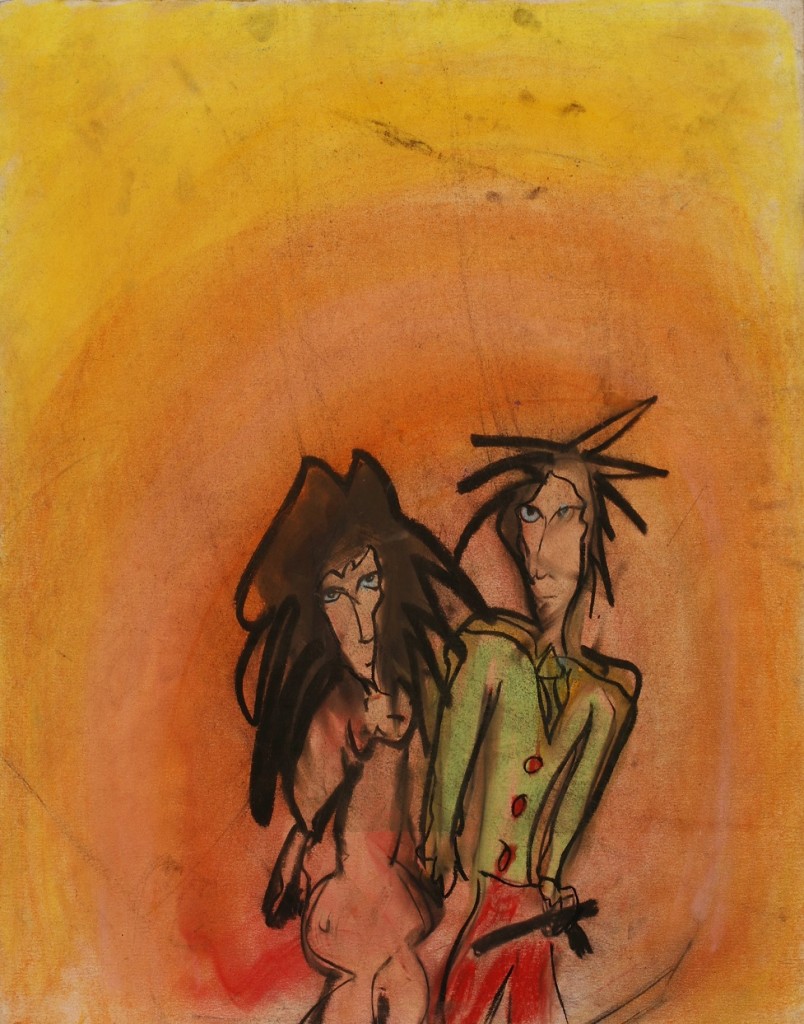
How you will find your audience is key to getting your film seen, distributed and profitable. Indy dramas will attract marketing dollars and distribution offers when they have big names attached unless the content is edgy enough to attract a major film festival or distribution offers. Or you can develop your own audience during the project that supports successful release and distribution.
A big name has a big following, but don’t limit yourself to the mainstream entertainment world. What about YouTube celebrities or blogger with a million followers? Or a film tied into an iconic figure with millions of fans.
These have an audience that wants to see their work and it’s likely you won’t have to pay top dollar for their name. A big name in mainstream entertainment may attract the marketing dollars needed to find the audience, but a huge audience isn’t required to make a film a success. Check out the case studies for examples of that.
What’s Your Hook?
Without a big name or festival, having a hook to connect with a target audience creates an audience that will show up to see the film. When the big name and marketing dollars aren’t there to attract the audience, Sheri’s two European case studies prove that focused effort finds the target audience by getting the word out to them through social media, community, and news channels. In each case, the filmmaker developed warm, substantive relationships with their target audience and surprising success followed.
Each had one or more ‘hooks’ to defined audiences they developed with great success—one over years and the other rapidly (in the year after the film was completed!) Both films were dramas with defined target audiences: a UK-based filmmaker with an ethnic, low budget, coming of age drama; and an India-based filmmaker with a drama released in a regional Indian dialog, with lots of interest from Europe, especially the UK.
So what’s your hook and how are you connecting with the community that will care about your story? Does the community trust you and know your work? If they do, they will want to help when you make your ask for funds or support during release!
Connecting with this audience from the start of your project and asking your audience to be part of the process engages and invests them in buying and sharing the final release. Sheri gives some great examples on how to engage your audience during the process. YouTube is a way to connect with your audience but she warns that people understand social media for relationship building and usually find it a turnoff when used for marketing so use it wisely. It is valuable for some topics…like sharing about a project on an iconic star or engaging fans for their feedback on the direction you’re taking in your story or soundtrack.
Don’t Worry About Distribution If You Have Your Audience
With all the digital distribution platforms now available, distribution is no longer a challenge. But who’s going to watch it? Marketing to your audience must be your focus from the start. Filmmakers can plan audience development and marketing at the beginning of the film.
With the speed of change on the internet, distribution agents simply aren’t able to keep up with the new digital distribution strategies. Online film review publications are now incentivized (The Guardian, The Times of India) using strategies like Distrify to earn royalties on the film reviews that result in click-throughs to view a film.
When you have a hook and plan audience development into your project, magic happens. In one case study, the audience was so invested during the process that, when the filmmaker offered an affiliate program at release, 130 affiliates signed up immediately to help market the film and earn royalties on distribution.
He used Distrify to offer and host the film for streaming, providing affiliates with unique affiliate embed codes. Affiliates ‘prebought’ the film at buyin levels that increased their royalty with higher prebuy values – even up to 75% royalty. WOW. Affiliates made thousands and so did he.
There are Hundreds of Digital Platforms for European Distribution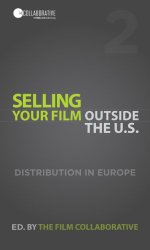
European distribution requirements are similar to US – they are looking for celebrity names (that are known in Europe), or films shown in a large festival, or films that have a record of large domestic distribution. Some genres attract distribution regardless of names or festivals because they have large demand, i.e. horror, thematic, sci-fi and family films. Straight drama and comedy don’t always travel well to foreign markets.
The sheer number of Video on Demand services in Europe is staggering – 447 – so many more than in the US. That means that with some acclaim, your film can reach many viewers. However, these revenue streams are paying less for a title so you’ll have several deals for distribution in Europe rather than one big deal as in the US market. European catalogs are looking at buying slates so these may only pay a license fee, not a transactional fee. Collaborating with other producers to present a slate increases your film’s chance of being sold in bulk this way.
US Distribution
The Film Collaborative has a great program for US distribution. TFC is an ‘aggregator’ for premium platforms like Amazon and ITunes. For a flat fee, your film will be encoded and uploaded to premium platforms and you’ll receive royalties directly from TFC as a direct pass-through – no transactional fees are charged. This is a great way to get your film into domestic digital distribution.
Be sure to listen to this great show 5 Creative Ways to Sell Your Film and check out the links below.
- filmcollaborative.org, @filmcollab on Twitter
- Sheri Candler’s Google+ community for filmmakers
By Elizabeth England
Did you know that 89% of IndieGoGo campaigns that reach their goal will overfund by 30% or more?
Or that 1/3 of IndieGoGo’s donors are international contributors from 70 countries?
These are just a few of the juicy tidbits I picked up listening to Carole Dean’s interview of IndieGoGo’s Marc Hoffstatter, Head of Film (@theoriginalhoff) on The Art of Film Funding on Blogtalkradio.
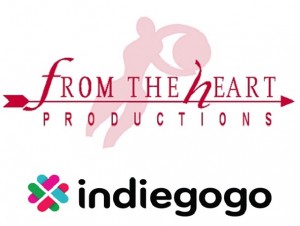
From the Heart has a unique partnership with IndieGoGo. As a 501(c)3 non-profit, From The Heart provides filmmakers with fiscal sponsorship which allows donors to get tax deductions. Filmmakers also get flexible funding. That means they get paid even if they don’t reach their goal. As an Indiegogo partner, From The Heart has helped filmmakers raise over $1 million to date.
I was delighted to pick up these expert insights and master tips, and give you an overview of the road map they shared.
Build Your Film Contact Database: 90% of your crowd funding comes from your list and their friends. During pre-launch, leverage your database to create excitement and get commitments for 20% of your campaign goal from funders. Then have a plan to get your committed funders to donate in the first two days of your campaign. Reaching 20% of your goal in the first 72 hours will get you noticed beyond your list by IndieGoGo fans and create momentum to fund to 100% of your goal ahead of schedule.
Aim Low – Fund High: Marc and Carole recommend being conservative in selecting your

goal to fund faster and stronger. Hitting that 20% in the first few days is crucial. It shows you’ve got support and creates momentum which attracts more donors. So, even if you want to fund your entire feature at once, it’s best to start by funding just part of it. Besides, 89% of the campaigns that hit their goal overfund by 30%.
Plan to Go Beyond Your Goal. Carole pointed out that many filmmakers reach their goal early and are at a loss as to what to do for the rest of the campaign. Marc suggested creating pre-planning stretch goals to keep the momentum going. For example, imagine telling your fans how stoked you are that you’ve reached 100% of your goal early and now you can do what you had only dreamed of…shoot that scene in 3D with another $2,000 (or whatever your first stretch goal is.) That early success is the juice keeping your fans engaged and your campaign exciting.
Don’t Forget The Pictures: Marc recommends that you make your Indiegogo campaign page a strong visual representation of who you are, what you are doing and your unique style and talent. It should not be a page filled with words. Potential donors must be visually drawn in by your campaign page. They want to see your style and get a taste of what your filmmaking will achieve with their help!
No Time for Trailers. Carole and Marc agree that at the start of a campaign a Pitch Video is more important than a trailer. You need to show donors why you are making the project and why it needs to get made. Don’t forget to have an “ask” and a call to action to ask them to donate. But even your pitch video MUST represent your filmmaking vision and style AND give them a reason to click ‘Donate NOW.’ Chances are, they aren’t coming back, so close them NOW.
My own two cents? Consider this – Make a pitch video with two endings: One for pre-launch promotion and the second for the campaign ask and close. Another key element on your campaign page is your team: who is on board with you and what are their roles? Your team inspires confidence in your ability to get the job done with their money, so let your funders know you have quality business and creative talent on board to finish the project.
Pre-planning is Critical: Marc suggests to plan what you are going to do to maintain momentum and excitement at 5, 10, 17, even 22 days into your campaign. Work out predefined benchmarks for stretch goals, pre-written social media content for both during and beyond your campaign, and new and exciting perks that stimulate new funders.
Out With the Old Perks. Plan to introduce exciting new perks during your campaign that stimulate funding. Some funders may prefer a credit over a premiere ticket so changing up the perks will attract new funders. Choosing smart perks like digital downloads and experiences are easier to fulfill and have less impact on your budget than a perk you have to pay for and ship.
Your Crew is Your Team. Mark recommends having a team on your campaign of at least four. 1- outreach to those organizations and individuals aligned with your project to get their support; 2- provide regular updates, responses and new perks on your campaign page; 3- email campaign management and response; and 4- social media content and interaction. Carole and Mark emphasize that you are marketing your film already at this early stage–building a fan base, and hopefully attracting the attention of sales agents, distributors and advocates so treat it that way.
Other key points covered:
- Campaign sophistication will jump in the near future with the entry of major players into the crowdfunding arena as seen in the recent campaigns for Sharknado and Rooster Teeth—this is great for getting your project noticed now by serious film fans and funders.
- Crowdfunding blogs and thought leaders are interested in your campaign and your project—so add PR outreach to your planning.
- Your success at funding your campaign is directly proportionate to retaining creative control of your project. Crowdfunding averages 10% to 35% of a film’s total budget funding, with the balance from grants, equity financing, foreign sales agreements.
- Crowdfunding is still relatively unknown and is poised for tremendous growth as market awareness explodes and the impact of recent Title II and Title III rulings make room for crowdfunding equity financing with both accredited and unaccredited investors.
The bottom line is that crowdfunding is far from maturity and is the best tool available for filmmakers to simultaneously get exposure for their talents while marketing and funding their projects.
From the Heart’s unique partnership with IndieGoGo gives you a powerful advantage: a flexible and continuous funding platform combined with decades of experience mentoring filmmakers. Take advantage of this priceless access to this winning combination now.
Here are some cool links I found researching this article that I’d like to share with you:
June 24th Google Hangout with Marc Hofstatter: http://www.indiewire.com/article/attention-filmmakers-learn-how-to-crowdfund-successfully-in-upcoming-google-hangout-with-indiegogo-kickstarter-and-seed-spark-20140619#.U6SBOREN9Ec.twitter
IndieGoGo’s Essential Tips: http://go.indiegogo.com/blog/2014/06/essential-tips-for-running-an-indiegogo-campaign-part-ii.html
Title II and IndieGoGo: https://go.indiegogo.com/blog/2013/09/update-on-the-jobs-act-title-ii-and-crowdfunding.html
 Don’t get lost in the crowd
Don’t get lost in the crowd
Stand out and get funded with From The Heart and Indiegogo.
No penalty if you don’t reach goal, tax deductions for donors, personal mentoring and support.
Just apply at the From The Heart Indiegogo Partner Page
Guest blog post by my brilliant friend, By Adrienne Gould
With the onset of instant communication, we live in interesting times. The wealth of information exposes more ways for people to expand their knowledge; people are willing today, more than ever before, to accept the role “thoughts” have in realizing a better future.
Many books published in recent years give credence to the power that positive thoughts, via the use of affirmations, are directly related to your lives circumstances.
Today, there is a new way of thinking, and with Carole Dean’s class on Intentions quickly approaching, I’d like to explain the differences between affirmations and declarations.
The difference between an affirmation and a declaration is slight, but in my mind, powerful. The definition of an affirmation is “a positive statement asserting that a goal you wish to achieve is already happening. I‘m not crazy about this because what it does is bring an automatic response to your mind that says, “This isn’t true.”
The definition of a declaration is “to state an official intention out loud that takes on a particular course of action“.
A declaration is not saying some-thing is true, it’s stating that we have an intention of doing or being something.
A declaration, by definition, is also official. It is a formal statement of energy into the universe and throughout your body.
Declare your intention aloud each morning and each evening. Additionally, if you do so while looking into a mirror, it will accelerate the process even more.
Now, I have to admit that when I first heard of this, I said, “No way, too hokey for me.” But, because I was broke at the time, I decided, “What the heck, I’ll do the hokey thing, I‘d rather be really hokey and really successful than really cool and really broke.”
After achieving the goals I’ve declared, it’s no surprise that I believe in declaring intentions.
* * * * *
Here are two ‘people habits’: Doing habits and Not-Doing habits. The way to change Not-Doing habits into Doing habits is to DO them. Reading will assist you, but it is a completely different world when you go from reading to doing.
* * * * *
designmagic@roadrunner.com Adrienne Gould 805-443-6826

